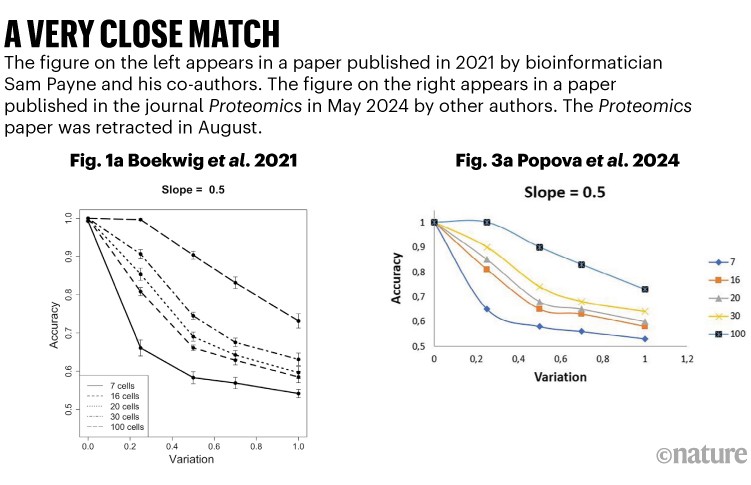
Bioinformatician Sam Payne stumbled on a manuscript in March that included figures that, he says, looked identical to those in a paper he published in 2021.Credit: Getty
When bioinformatician Sam Payne was asked to review a manuscript on a topic relevant to his own work, he agreed — not anticipating just how relevant it would be.
The manuscript, which was sent to Payne in March, was about a study on the effect of cell sample sizes for protein analysis. “I immediately recognized it,” says Payne, who is at Brigham Young University in Provo, Utah. The text, he says, was similar to that of a paper1 he’d authored three years earlier, but the most striking feature was the plots: several were identical down to the last data point. He fired off an e-mail to the journal, BioSystems, which promptly rejected the manuscript.
In July, Payne discovered that the manuscript had been published2 in the journal Proteomics, and he alerted the editors. On 15 August, the journal retracted the paper. An accompanying statement cited “major unattributed overlap between the figures” in it and Payne’s work. In response to questions from Nature, a spokesperson for Wiley, which publishes Proteomics, said, “This paper was simultaneously submitted to multiple journals and included plagiarized images.”
AI is complicating plagiarism. How should scientists respond?
The retraction statement also stated that four of the authors said they “did not participate in the writing and submission of the article and gave no consent for publication”, and that the fifth author did not respond. However, Nature’s news team found links between several of the authors and International Publisher, a paper mill based in Moscow. Neither the authors nor International Publisher responded to Nature’s requests for comment.
The alleged plagiarism of Payne’s paper highlights systemic vulnerabilities in the global research community, says Lisa Rasmussen, editor-in-chief of the journal Accountability in Research. According to one analysis, roughly 70,000 papers with characteristics common to work produced by paper mills were published in 2022 alone.
Despite the scale of the problem, there is no Interpol equivalent for journals, nor an official authority to provide industry-wide alerts about suspicious manuscripts. “It was just a complete lucky break that the person asked to review it was the author,” Rasmussen says. “Obviously our system should not depend on that kind of serendipity.”
Carbon copy
Although some figures in the BioSystems manuscript were direct copies of those in Payne’s paper, others were simply replotted using his data, which are publicly available, he says. He shared the disconcerting experience on X, formerly known as Twitter. “Well, it happened,” he wrote. He was reviewing a manuscript, he wrote in a post, that included “a direct copy of the figures” in one of his own papers.

Source: Ref. 1 and Ref. 2
When, months later, he discovered the Proteomics paper, he posted a follow-up. “Well. It REALLY happened” — the paper that he had been asked to review had been published. Two weeks later, Proteomics retracted the paper, citing plagiarism of images.
Unlike the figures, the main text of the Proteomics paper is similar to that of Payne’s, but not identical. For example, Payne and his colleagues wrote:
“From the large population of 10,000 cells, we subsampled a given number of cells n_sample ∈ [7, 16, 20, 30, 100] and calculated S/Vest.”
The corresponding paragraph of the Proteomics paper features the same numbers and many of the same words:
“The authors calculated S/Vest using sample n = [7, 16, 20, 30, 100] cells from a population of 10,000 cells.”
The use of the third person caught Payne’s eye. He says such oddities led him to think his paper had been paraphrased using artificial intelligence (AI) to create believable but different text.
Paper pushing
In the course of reporting, Nature found links between authors of the Proteomics paper and a paper mill. Two authors, Dmitrii Babaskin and Tatyana Degtyarevskaya, both at the I.M. Sechenov First Moscow State Medical University, had separate articles3,4 retracted from the International Journal of Emerging Technologies in Learning. Both retraction statements, issued in July 2022, use the same language: “The work could be linked to a criminal paper mill selling authorships and articles for publication.”
As evidence, the statements cited the work of Brian Perron — who studies social work at the University of Michigan in Ann Arbor and also works as a misconduct sleuth — and his colleagues, who had found links between both of the retracted papers and International Publisher. Neither Babaskin nor Degtyarevskaya responded to Nature’s requests for comment about the retractions.
Publishers unite to tackle doctored images in research papers
International Publisher’s website advertises a selection of more than 10,000 manuscripts, on topics as diverse as the metallurgy of aluminium-alloy welding and the biological features of quails. Prospective buyers can see the paper’s title, and sometimes its abstracts, as well as the expected ranking in the citation database Scopus of the journal of publication. They then select an author slot, with costs ranging from about US$500 to $3,000. The company promises that titles and abstracts shown online will be “completely changed” for publication. “No one will ever be able to find the manuscript anywhere,” the website declares.
Nevertheless, in 2021, Perron and his colleagues reported on the scientific-fraud watchdog website Retraction Watch that they had identified nearly 200 published papers that probably originated from International Publisher. A number of the published titles “were almost word-for-word” the same as those listed for sale, Perron says. Many of the papers listed in the Retraction Watch report were later retracted. Asked for comment on allegations that it is a paper mill, International Publisher did not respond.
Clearing the catalogue
International Publisher removes paper listings from its online catalogue after papers are purchased. To get around this, Nature examined a database of past International Publisher paper listings, created by Perron, and combed through screenshots of the paper mill’s website taken by the non-profit organization Internet Archive, based in San Francisco, California. The search showed that the titles of multiple articles published by four of the five authors of the Proteomics study matched the titles of papers previously listed for sale by International Publisher.
Biomedical paper retractions have quadrupled in 20 years — why?
These paper listings do not include the full article text, but strong circumstantial evidence connects the paper mill’s listings to published studies. For example, a screenshot of the paper mill’s website taken in September 2021 shows that among the articles for sale was #1584, “The structure of forest vegetation on industrial dumps of different ages.” Degtyarevskaya was an author of a paper published in Ecology and Evolution5 in July 2023 with a nearly identical title and matching abstract. In response to an enquiry from the news team, Ecology and Evolution said that it is now investigating the matter.
Although Nature’s news team was unable to locate a sales listing on International Publisher’s website for the Proteomics paper, Perron says that the paper has several hallmarks of paper-mill articles. Nature could not find any other studies published by the authors on the paper’s subject matter, protein analysis. Moreover, the manuscript was submitted to BioSystems while it was still under review at Proteomics. Perron says that submitting a manuscript to more than one journal simultaneously is a classic tactic of researchers trying to publish paper-mill products.
A spokesperson for Wiley did not specify whether the allegedly plagiarized Proteomics paper came from a paper mill, but said: “Our investigation confirmed that systematic manipulation of the publication process was at play.”
Check and check again
In recent years, some publishers and journals have taken extra countermeasures against plagiarism and paper mills. One such effort, developed by the International Association of Scientific, Technical and Medical Publishers (STM), a trade organization in The Hague, the Netherlands, is the STM Integrity Hub, a resource for scientific publishers that includes a ‘paper mill checker tool’ and ‘duplicate submission checker tool’. The latter is in use at more than 150 journals and scans more than 20,000 papers each month. More than 1% are identified as duplicates.
There are no metrics for how often researchers spot plagiarism of their own work, but several researchers responded to Payne’s social-media posts by sharing that they had found themselves in a similar situation.
For Payne, the prospect of paper mills taking advantage of AI is a daunting one. “This, I think, is a pretty good con,” he says. “I think it’s going to happen more.”





